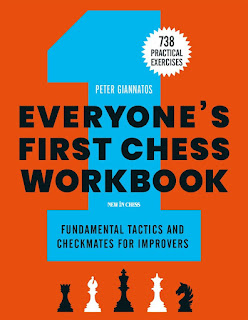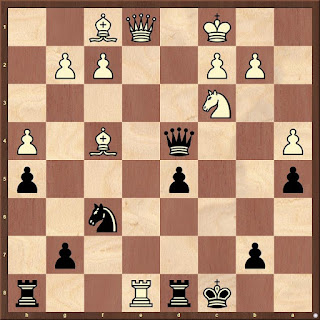BOOK REVIEW by Carl Portman
EVERYONE’S FIRST CHESS WORKBOOK
– FUNDAMENTAL TACTICS AND
CHECKMATES FOR IMPROVERS
by PETER GIANNATOS
Peter Giannatos
NEW IN CHESS
2021
1st edition (softcover, 344 pages)
What is this book about? (The back cover says…)
Working
on chess tactics and checkmates will help you win more games. It develops your
pattern recognition and your ‘board vision’ – your ability to capitalize on
opportunities. This Workbook features a complete set of fundamental tactics,
checkmate patterns, exercises, hints, and solutions.
Peter
Giannatos selected 738 exercises based on ten years of experience with
thousands of pupils at the prize-winning Charlotte Chess Center. All problems
are clean, without unnecessary fluff that detracts from their instructive
value. The Workbook has ample room for writing down the solutions to the
exercises. This is helpful for both students and coaches, who can assign
homework from the book without having to worry about being unable to review the
solutions. And writing down the correct chess moves will greatly accelerate
your learning process.
Everyone’s
First Chess Workbook offers you a treasure trove of chess knowledge and more
than enough lessons to keep you busy for a year!
Contents
Foreword – by GM Daniel Naroditsky
Preface – by the author
Introduction
Part I (comprising four chapters on general
board visualisation)
Part II (comprising thirteen chapters on an
introduction to chess tactics)
Part III (Comprising four chapters on
Intermediate checkmates and combinations)
Part IV (Solutions to exercises)
My comments
I
have coached chess to players from beginner to intermediate – and sometimes
beyond – for many years. I have always gathered my material from different
books and online resources, as well as actual classroom experiences. Here we
have much of what I would want in one single volume.
The
pupil reading this then will already know how to play chess in terms of the
rules and the basic moves. This book aims to improve board visualisation and
tactical ability. It is not a strategy book. Pattern recognition is crucial for
the improving chess player and this book focuses greatly on this.
One
aspect of the book that I found of particular use was Chapter 19 – themed
checkmate patterns. Many people (including some strong players) are unaware
that some checkmates have actual names, because of their unique pattern and might
be named after people long since departed. One example is ‘Boden’s mate which
is a specific checkmate with two bishops. Here is an example position
below. White to play (coming down the board) and checkmate Black in three
moves, using Boden’s mate. Can you do it?
There
are many other mates ranging from Anastasia’s and the ‘Kill Box mate to the
Epaulette mate and Vukovic’s mate – but would you know which is which? It’s
important to know these in my view, because they help to put a picture in the
student’s head and therefore better focus the mind at the board.
With
regard to tactical themes, there are examples in each chapter introduction,
followed by guided practice and then tests. They are great fun to do and any
student learning the game is bound to be filled with joy and wonder, if
skillfully encouraged. The answers are given at the end of the book in a very
logical and easy to follow way, headed with each topic and theme. Nice.
Does the book achieve its aim?
What
is the goal of the book? Well, the author explains this in his
introduction by remarking that studying will provide students with the resources
they need to establish a fundamental level of checkmating and tactical
abilities. I could best proffer an opinion about whether it achieved this aim
or not by actually asking students who have used it. However, having just
received the book I have not done that yet. I have absolutely no doubt
whatsoever that any student from unrated up to maybe around 1300 (the target
audience) who diligently works through this book will benefit enormously. I can
only imagine owning and cherishing such a book when I learned to play at the
rather late age of twelve.
Note: this is not just a book for juniors but
for chess players of any age, since our beloved game has no boundaries in that
and many other areas. It is clear that the author has spent a good deal of time
writing this and we coaches should be delighted that he is willing to share his
expertise, and love for the subject, honed over many years. He has done so in a
format that is easily understandable and very logical.
There is one final point. This is not only
a book. It is a workbook. Therefore, I would envisage each and every student
having a copy to keep, but the price would therefore have to be built in to
each initial costing when engaging a new student. It is around £23 at the time
of writing, but then the student gets to keep it forever, and it is well worth
it.
To conclude. This is a lovely book for
coaches, aimed at people who already know the basics but want to improve
further. Containing tactics and pattern recognition with easy-to-understand
text and 738 practical exercises, this is a timely addition to the market. I
wish I had 50 copies, when I could change many new worlds.
Who is the author?
Peter Giannatos is the founder and executive director of
the Charlotte Chess Center & Scholastic Academy, in Charlotte, North
Carolina, USA. Peter has been teaching and organizing chess for more than 10
years. As a teenager, he boosted his chess rating from 589 to over 2000 USCF in
less than four years. Since then, Peter has achieved both the FIDE Master title
and the US Chess National Master title. He now spends most of his time teaching
his students the same techniques he used to rapidly improve.






No comments:
Post a Comment